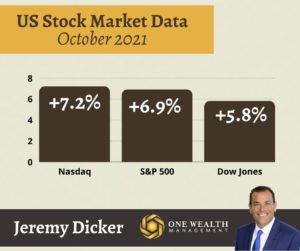

October economic & market recap: Wall Street booms, inflation bites, and the Fed to start their taper.
A Banner Month for Wall Street
In October, Wall Street had its best month of the year, with the S&P 500 gaining 6.9% from October 1st to 31st. That’s the S&P’s highest monthly gain since November 2020, when the stock market responded to a new president and optimistic news about possible coronavirus vaccines.
The Nasdaq (+7.2%) and Dow Jones (+5.8%) posted similar gains.
Wall Street’s S& P 6.9% gain last month was a welcome change from September 2021, when the S&P 500 gained only 4.8% for the month, the index’s worth month throughout 2021.
There are plenty of reasons for the positive turnaround: many corporate earnings reports surpassed investor expectations, pumping life into myriad individual stocks. In fact, just last Thursday, 244 companies of the S&P 500 reported their third-quarter results, with 82% of the exceeding Wall Street analyst’s expectations.
Tech stocks rallied in October, with Microsoft gaining 17% and Alphabet stock increasing by 11%. Energy companies gained momentum on the back of rising oil prices, with Chevron stock jumping almost 13% and Exxon Mobil almost 10% in October.

GDP and Economic Growth
In the third quarter of 2021, gross domestic product increased at a disappointing 2% annualized pace, the slowest rate of quarterly growth since April 2020. That slowdown even stumped economists, who anticipated a 2.8% rate of growth in Q3.
Supply chain woes, a shortage of goods like new automobiles, a peaking housing market, and a flare-up of the Delta variant all stifled GDP growth.
As evidence of the economy’s slowing growth, the International Money fund downgraded its estimate for U.S. economic expansion to 6.0% for the year, down from its forecast of 7.0% as recently as July.
In terms of current-dollar GDP, Q3 registered an increase of only 7.8%, adding $432.5 billion in the quarter to a level of $23.17 trillion. To put that in context, we saw the current-dollar GDP rise 13.4% in Q2 this year, adding $702.8 billion.
Personal Income
In October, Q3 data revealed personal income increases of $47.8 billion for the quarter, a windfall compared to the $1.29 trillion decrease in personal income in Q2.
However, personal income declined by 1% in September alone, far higher than the anticipated 0.4% decrease.
Disposable Personal Income fell by 0.7%, or $29.4 billion in Q3, a marked improvement from the 25.7% or $1.39 trillion drop in Q2.
For the 3rd quarter, the personal saving rate (personal saving as a percentage of disposable personal income) was 8.9%, or $1.60 trillion. That was down incrementally from Q2 when we saw a personal saving rate of 10.5%, or $1.90 trillion.
In September, that savings rate leveled off to 7.5%, or $1.34 trillion, down from the 9.2% savings rate in August.
Consumer Spending
Despite the lackluster numbers on economic growth and inflation concerns, consumer spending actually increased by 0.6% in September.
However, consumer spending – accounting for 69% of the $23.2 trillion U.S. economy – increased just 1.6% during Q3, after Q2 saw a remarkable 12% increase.
Consumer spending on goods (-9.2%) for the quarter were driven by a 26.2% drop in major purchases like automobiles and appliances, while spending on services dropped 7.9%.
Unemployment
We saw much-needed good news on the employment front last month, with new claims for unemployment benefits dropping to a 19-month low. Last week, a seasonally adjusted 290,000 Americans filed claims for new unemployment benefits with their state, the third week in a row unemployment numbers stayed below 300,000.
Wages and salaries rose 4.6% during September, compared to a 2.7% gain during September 2020.
Fed to Start Tapering
It was inevitable that the Fed started tapering their monthly bond purchases, slowing the floodgates of money pumped into the economy in response to the Covid-19 economic era. So, the recent Fed news was no shock, and the bigger question is now when the Fed starts tapering its asset purchases, expected as soon as mid-November or mid-December.
There’s also the concern of how aggressively the U.S. Federal Reserve, hoping to avoid the “temper tantrum” we saw when then-Fed chief Ben Bernanke blindsided Wall Street and investors with a sudden pull-back in 2013.
While the Fed is not signaling anything as abrupt or dramatic, the U.S. bond market is on track for its first yearly loss since that year, 2013.
Inflation Watch
The latest data – covering through September – reveals that headline inflation has gained 4.4% annually, the largest growth since January 1991. Core inflation (taking out food and energy costs) increased 3.6% for the last 12 months, which was the same pace as August but also the fastest inflation gain in 30 years.
Obviously, energy costs lead the inflationary pressure, with a 24.9% annual increase. Food costs (4.1%), services (6.4%), and goods (5.9%) also have a higher price tag now.
Quote of the month:
“Year-over-year inflation remains high and will for some time simply because of what’s already happened in the first months of the year. But monthly rates I believe will come down in the second half of the year. I think we’ll see a return to levels close to 2%.”
-Janet Yellen
Treasury Secretary and former Fed chair
Fascinating Financial Fact
The average national car price is now $43,300. That’s not notable in itself until you realize that the average price has gone up 10% year-over-year.
For used cars, the national average – $26,300, has gone up an alarming 20% year-over-year!
Of course, the rising cost of vehicles is not just due to standard inflation, but a global shortage of semiconductors needed to produce new cars and trucks and the subsequent supply shortage that’s driving up the cost of used vehicles. Fewer motor vehicles were produced in September than any time since 2010, save for the initial economic shutdown in spring 2020.
Big Winner:
With its reported deal to provide 100,000 electric cars to Hertz, Tesla’s stock jumped 12.6% virtually overnight, surpassing $1 trillion for the first time.
And while Tesla founder Elon Musk confused the issue (and sent the stock back to earth) by going on record that the contract isn’t actually signed yet, Hertz reports that Tesla has already started delivering vehicles, so it’s probably a foregone conclusion and just a last-minute negotiating ploy by Musk.